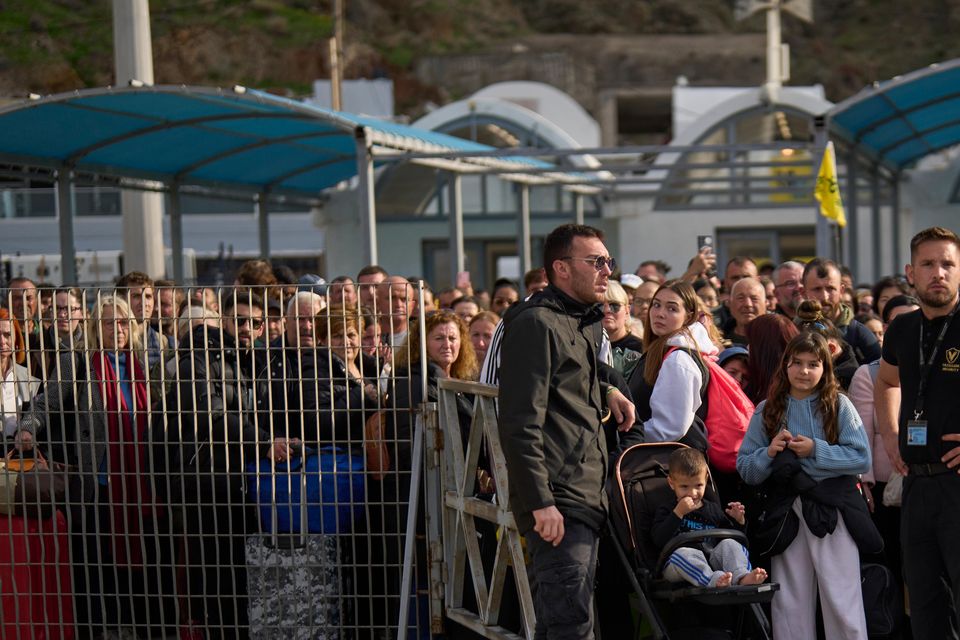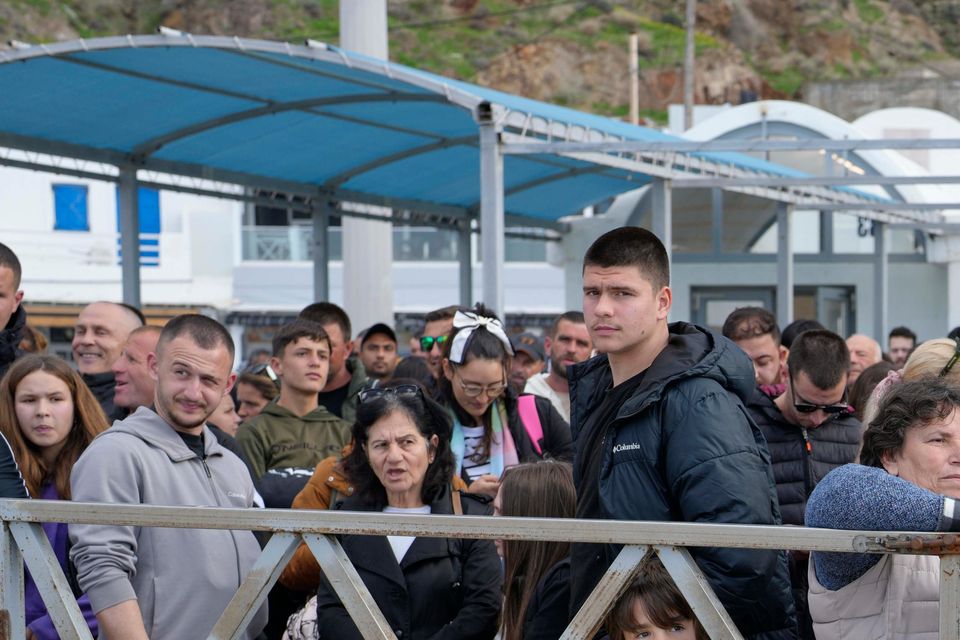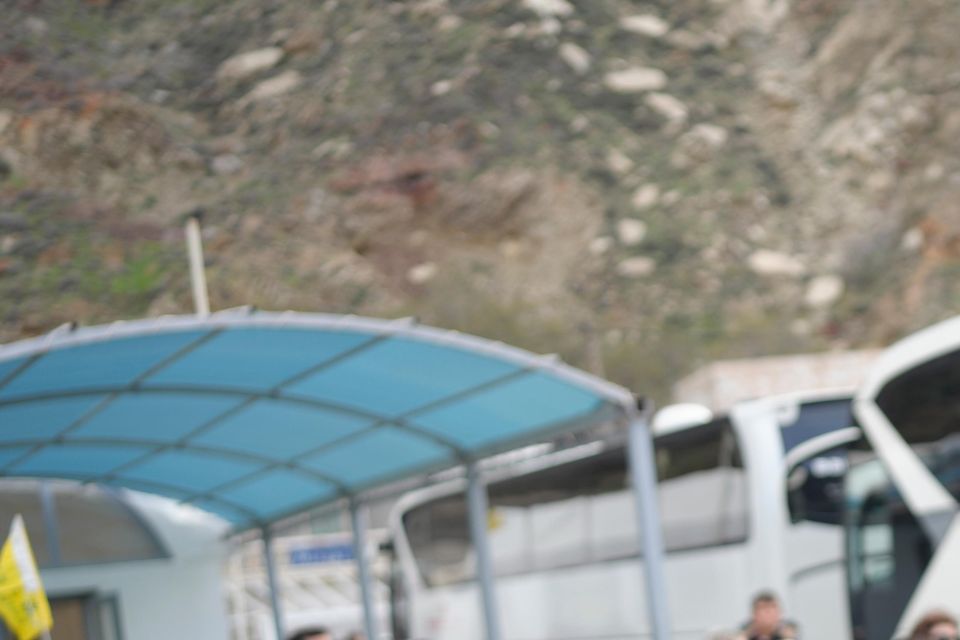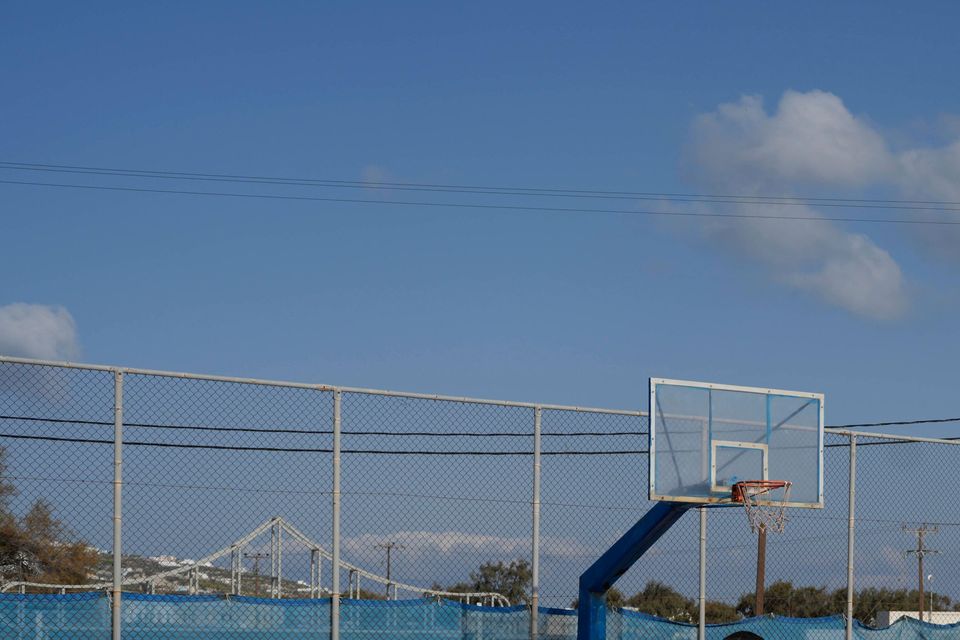Authorities have deployed emergency rescue crews to Greece’s volcanic island of Santorini as hundreds of people scrambled to leave after a spike in seismic activity raised concerns about a potentially powerful earthquake.
Precautions were also ordered on several nearby Aegean Sea islands — all popular summer vacation destinations — after more than 200 undersea earthquakes were recorded in the area over the past three days.
“We have a very intense geological phenomenon to handle,” Prime Minister Kyriakos Mitsotakis said from Brussels, where he was attending a European meeting. “I want to ask our islanders first and foremost to remain calm, to listen to the instructions of the civil protection (authority).”
Passengers wait for the arrival of a ferry to Athens (Petros Giannakouris/AP)
Mobile phones on the island blared with alert warnings about the potential for rockslides, while several earthquakes caused loud rumbles. Authorities banned access to some seaside areas, including the island’s old port, which are close to cliffs.
“These measures are precautionary, and authorities will remain vigilant,” civil protection minister Vasilis Kikilias said late on Sunday after an emergency government meeting in Athens. “We urge citizens to strictly adhere to safety recommendations to minimise risk.”
While Greek experts say the quakes, which have reached magnitude 4.9 are not linked to Santorini’s volcano, they acknowledge the pattern of seismic activity is cause for concern.
Government officials met scientists throughout the weekend and on Monday to assess the situation, while schools were ordered shut on the nearby islands of Amorgos, Anafi and Ios for the week.
The frequency of the quakes, which continued throughout Sunday night and into Monday, has worried residents and visitors.
Experts say the quakes have reached magnitude 4.9 (Petros Giannakouris/AP)
“I have never felt anything like this and with such frequency — an earthquake every 10 or 20 minutes. Everyone is anxious even if some of us hide it not to cause panic, but everyone is worried,” said Michalis Gerontakis, who is the director of the Santorini Philharmonic Orchestra.
Residents and visitors were advised to avoid large indoor gatherings and areas where rockslides could occur, while hotels were instructed to drain swimming pools to reduce potential building damage from an earthquake.
Fire service rescuers who arrived on the island on Sunday set up yellow tents as a staging area in a basketball court next to the island’s main hospital.
Some residents and local workers headed to travel agents seeking plane or ferry tickets to leave the island.
“We’ve had earthquakes before but never anything like this. This feels different,” said Nadia Benomar, a Moroccan tour guide who has lived on the island for 19 years. She bought a ferry ticket on Monday for the nearby island of Naxos.
“I need to get away for a few days until things calm down,” she said.
The Prime Minister has appealed for calm (Petros Giannakouris/AP)
A queue of cars and hundreds of people formed at the island’s main port on Monday afternoon to catch a ferry leaving Santorini.
Others said they were willing to take the risk. Restaurant worker Yiannis Fragiadakis had been away but said he returned to Santorini on Sunday despite the earthquakes.
“I wasn’t afraid. I know that people are really worried and are leaving, and when I got to the port it was really busy, it was like the summer,” he said. “I plan to stay and hopefully the restaurant will start working (for the holiday season) in three weeks.”
Crescent-shaped Santorini is a premier tourism destination with daily arrivals by commercial flights, ferries and cruise ships. The island draws more than three million visitors annually to its whitewashed villages built along dramatic cliffs formed by a massive volcanic eruption — considered to be one of the largest in human history — more than 3,500 years ago.
A firefighter walks among tents set up at a basketball court to accommodate fire service rescuers (Petros Giannakouris/AP)
That eruption, which occurred around 1620 BC, destroyed a large part of the island, blanketed a wide area in yards of ash and is believed to have contributed to the decline of the ancient Minoan civilisation, which had flourished in the region.
Although it is still an active volcano, the last notable eruption occurred in 1950.
Greek seismologist Gerasimos Papadopoulos warned that the current earthquake sequence – displayed on live seismic maps as a growing cluster of dots between the islands of Santorini, Ios, Amorgos and Anafi — could indicate a larger impending event.
“All scenarios remain open,” he wrote in an online post. “The number of tremors has increased, magnitudes have risen, and epicentres have shifted north east. While these are tectonic quakes, not volcanic, the risk level has escalated.”



